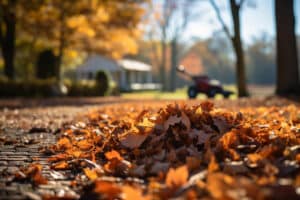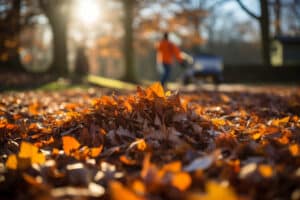How Do Leaf Blowers Function?
Key Takeaways
- Leaf blowers function by creating a powerful stream of air to move leaves and debris.
- There are three main types of leaf blowers: gas-powered, electric (corded and cordless).
- Leaf blowers can have both a blowing function and a vacuuming function, with the efficiency of vacuuming generally lower than blowing.
Leaf blowers are popular gardening tools that help homeowners and professionals keep their lawns and gardens tidy. They work by creating a powerful stream of air that can be used to move leaves and debris. In this article, we will explore the science behind how leaf blowers function and the different types of leaf blowers available.
The Basic Mechanism
Leaf blowers operate using a simple mechanism. They consist of a motor, a fan, and a nozzle. When the motor is turned on, it powers the fan, which rotates at high speeds. This rotation creates centrifugal force, which sucks in the surrounding air and forces it into the fan. The fan then pushes the air out of the nozzle, creating a constant airflow.
Different Types of Leaf Blowers
Leaf blowers can be categorized into three main types based on their power source: gas-powered, electric, and cordless.
Gas-Powered Leaf Blowers
Gas-powered leaf blowers use a combustion engine to generate power. They are typically more powerful than electric blowers and are commonly used by professionals for larger areas. Gas blowers require regular fueling and maintenance, and they emit exhaust fumes during operation.
Electric Leaf Blowers
Electric leaf blowers are powered by an electric motor. They can be further classified into two subcategories: corded and cordless.
Corded Electric Leaf Blowers
Corded electric leaf blowers need to be connected to a power source through a cord. They provide a continuous power supply, but the range is limited by the length of the cord. They are generally quieter and more environmentally friendly than gas blowers.
Cordless Electric Leaf Blowers
Cordless electric leaf blowers are powered by rechargeable batteries. They offer greater mobility and flexibility compared to corded electric blowers. However, their runtime is limited by the battery capacity, and they may require recharging during use for extended periods.
Leaf Blower Functions
While the primary function of leaf blowers is to blow leaves and debris away, some models also have a vacuuming function.
Blowing Function
The blowing function of leaf blowers is achieved by directing the airflow towards the desired area using the nozzle. By adjusting the angle and intensity of the airflow, the operator can move and gather leaves into piles or blow them away completely.
Vacuuming Function
Leaf blowers with a vacuuming function have a specialized nozzle that can suck in air, leaves, and debris. The collected material is then stored in an attached bag or container. It’s important to note that the efficiency of vacuuming is generally lower than blowing, so it is recommended to first blow the leaves into a pile before vacuuming.
The Science Behind Leaf Blowers
The science behind leaf blowers involves utilizing centrifugal force and airflow to create a powerful stream of air. The motor powers the fan, which generates the airflow. The size and design of the nozzle play a crucial role in determining the speed and impact force of the airflow.
Nozzle Design
The diameter and shape of the nozzle affect the power output of the leaf blower. Smaller nozzles create higher speed airflow, while larger nozzles generate higher impact force. Manufacturers design leaf blowers with different nozzle sizes to cater to various needs and preferences.
Engine Types
Gas-powered leaf blowers typically use either two-stroke or four-stroke engines. Two-stroke engines require a mixture of oil and gasoline for fuel, while four-stroke engines use separate fuel and oil compartments. Electric leaf blowers, on the other hand, are powered by an electric motor that can be either main-powered or battery-powered.
Sound and Noise Levels
While leaf blowers are efficient tools for outdoor maintenance, they can also be a source of noise pollution. Commercial leaf blowers emit a low-frequency noise that can be irritating to humans. Studies have shown that the sound levels from leaf blowers often exceed recommended standards set by the World Health Organization. The low-frequency sound can penetrate building walls and is not well tolerated by people.
Conclusion
Leaf blowers function by utilizing an electric motor or a gasoline engine to drive the fan’s blades, creating centrifugal force that sucks in the surrounding air. The air is then pushed out of the nozzle, creating a constant airflow. The speed and impact force of the airflow depend on the diameter of the nozzle. Some leaf blowers also have a vacuuming function where the nozzle can suck in air, leaves, and debris, which are collected in an attached bag. The efficiency of vacuuming is lower than blowing, so it is recommended to first blow the leaves into a pile before vacuuming.
Related Websites:
FAQs:
Q: What is the purpose of a leaf blower?
A leaf blower is designed to quickly and efficiently clear leaves, grass clippings, and other debris from outdoor spaces. It saves time and effort compared to traditional manual methods like raking.
Q: What are the advantages of electric leaf blowers?
Electric leaf blowers are lighter, quieter, and more environmentally friendly than gas-powered options. They require less maintenance and are ideal for smaller yards or noise-sensitive areas.
Q: How do variable speed settings affect leaf blower performance?
Variable speed settings allow users to adjust the airflow and airspeed produced by the leaf blower. This flexibility makes it easier to tackle different tasks, such as blowing leaves off delicate flower beds or clearing heavy debris from larger areas.
Q: What safety precautions should I take when using a leaf blower?
When using a leaf blower, it is important to wear protective gear such as safety glasses, earplugs, and a dust mask. Always be mindful of your surroundings and avoid pointing the blower toward people, pets, or fragile objects. It is also recommended to follow the manufacturer’s guidelines and never modify the blower’s design or functionality.
Q: How can I minimize noise pollution when using a leaf blower?
To minimize noise pollution, consider using an electric leaf blower, as they are generally quieter than gas-powered ones. Additionally, using the leaf blower during reasonable hours and being mindful of your neighbors can help reduce noise disturbances. Some leaf blowers also come with noise reduction features or attachments that can further decrease noise levels.






